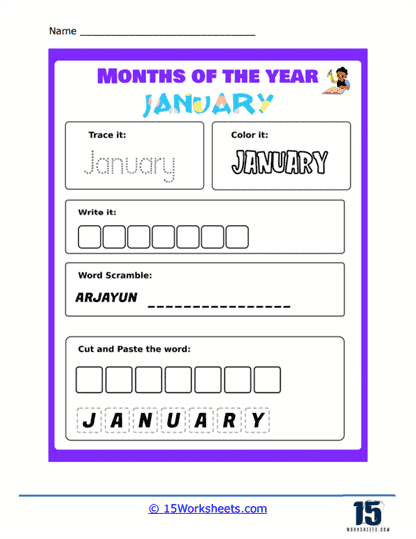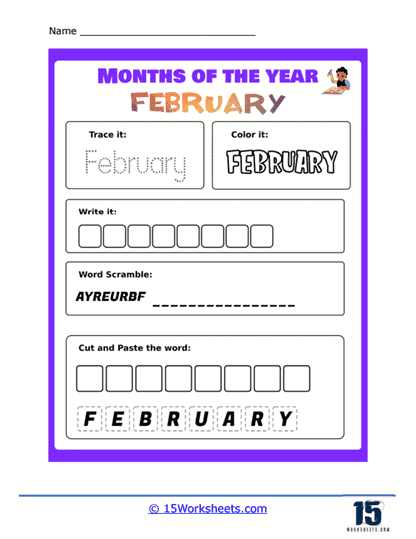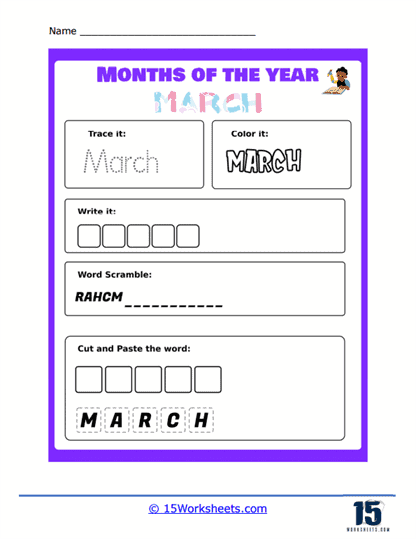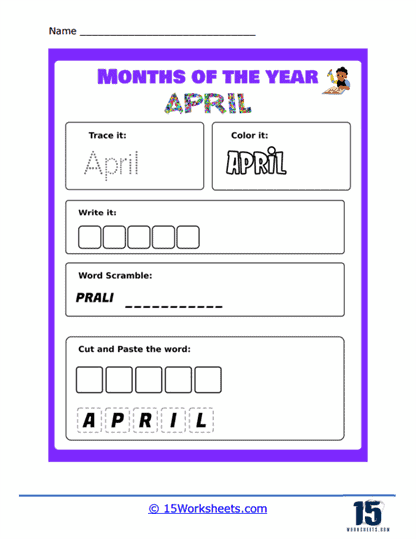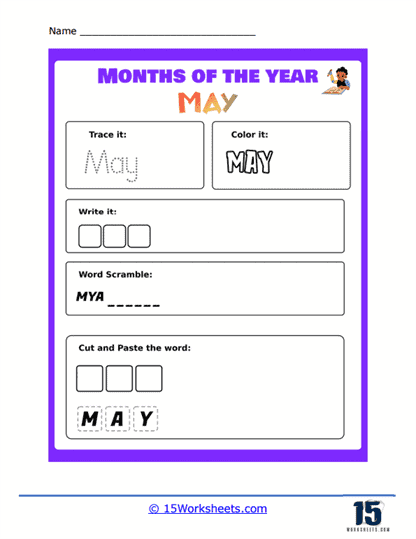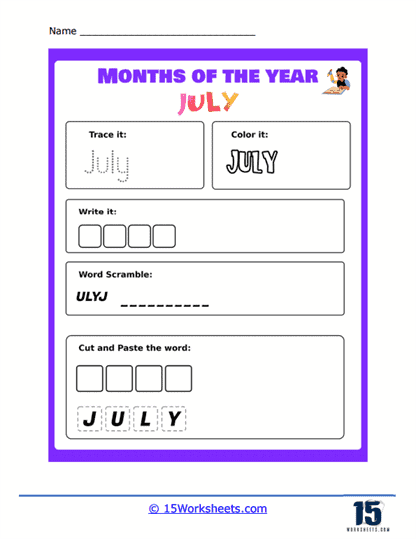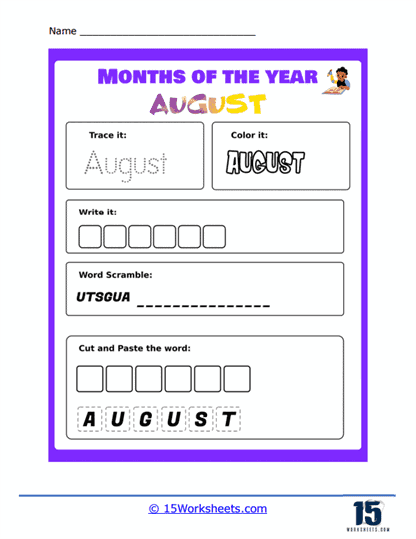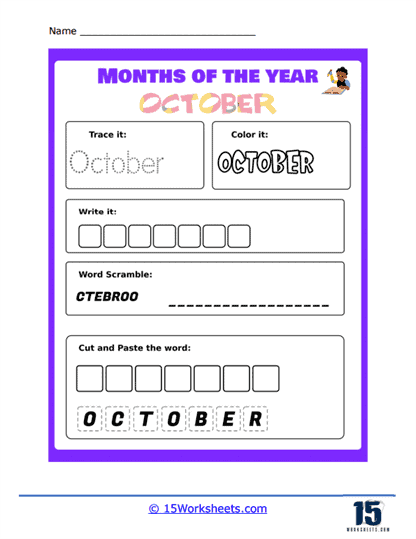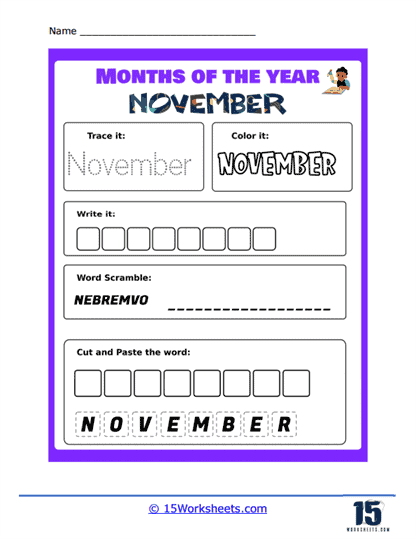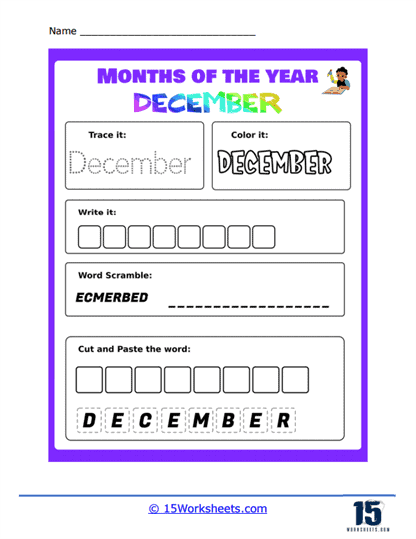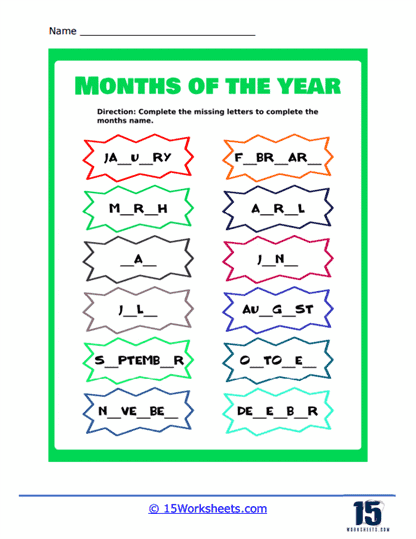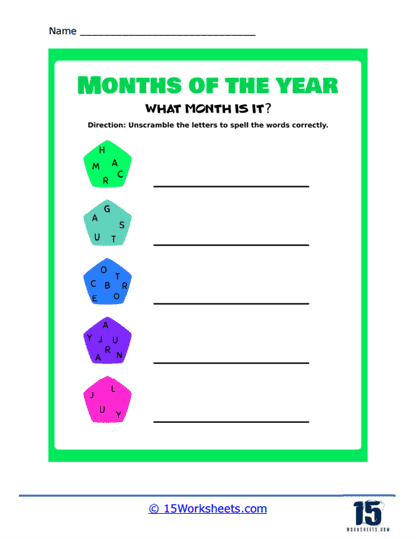Months of the Year Worksheets
About These 15 Worksheets
This series of worksheets will help young learners, particularly in early childhood education, understand the concept of time and sequence as it relates to the calendar year. These worksheets typically introduce children to the names and order of the twelve months, offering activities that promote recognition, memory, and basic organizational skills. The worksheets often include colorful images, fun puzzles, and engaging exercises that make learning interactive and enjoyable. Examples of activities may include matching the months to their corresponding seasons, tracing or writing the names of the months, or arranging the months in the correct order.
For kindergarten students, who are just beginning to develop a sense of time, Months of the Year Worksheets serve as an ideal introduction to the cyclical nature of the calendar. These students are in the early stages of grasping foundational concepts, like what a “year” is, and learning the months can be a fun way to establish a deeper understanding of routine and time progression. By working through these worksheets, students start to see patterns in the world around them-such as how months change in a predictable order and how seasons recur each year. This understanding builds upon their cognitive development by fostering critical thinking and memory retention.
Incorporating these worksheets into a kindergarten curriculum also aligns well with the age group’s developmental abilities. At this stage, children are honing their fine motor skills through activities like tracing letters and numbers, which is often a key component of these worksheets. They enjoy repetition and hands-on learning, and activities like coloring or cutting out months to glue them in order help reinforce the learning process in a tangible, engaging way. Furthermore, young learners are typically enthusiastic about holidays and birthdays, so associating certain months with key events can make the learning process feel more relevant and personal to them.
One of the most critical aspects of introducing these sheets to kindergarteners is that it helps them grasp the concept of sequencing and ordering. Understanding that January comes before February, or that summer follows spring, teaches them to think in linear patterns, a cognitive skill that applies to many aspects of learning, such as reading, math, and problem-solving. These worksheets encourage them to think in terms of beginning, middle, and end, which is an essential foundation for more complex thinking in later grades.
These worksheets can serve as a bridge for learning broader subjects, such as geography and science. As students begin to connect specific months to certain weather patterns, seasonal changes, and holidays, they naturally begin to ask more questions about the world around them. For instance, they might notice that winter occurs during December, January, and February, which leads to discussions about weather, temperature, and why these changes happen. This type of inquiry-based learning is crucial for young children, as it sparks curiosity and motivates further exploration of related topics.
Teaching Kids the Months of the Year
Teaching kids the months of the year is a foundational skill that not only helps them understand time but also enhances their grasp of how the calendar works. This understanding is essential for children as they begin to organize their days, anticipate special events, and navigate the world around them. The challenge for parents and educators lies in making this learning process both effective and enjoyable. Fortunately, there are a variety of engaging strategies that can turn this important task into a fun and interactive experience for children. Here are some creative approaches that can help.
Introducing the Concept of Months
The first step in teaching children about the months of the year is to explain what months are and how they fit into the larger framework of time. Begin by introducing the idea that a year is made up of 12 months, each with its own name and a certain number of days. Use simple, clear language that children can understand, and provide examples of months they might already recognize, like their birthday month or the month of a major holiday they enjoy. It’s also helpful to show them a calendar as a visual reference. This initial introduction can set the stage for a deeper understanding as children start to realize how months help organize the year.
Making the Month Names Stick
One of the most effective ways to help kids memorize the names of the months is by using visuals and repetition. Start by teaching the months in order, from January to December, using colorful calendars, flashcards, or interactive apps that display the names of the months clearly. Incorporating songs and rhymes is another powerful tool for helping children remember the sequence. Popular songs like the “Months of the Year” set to familiar tunes, such as “Ten Little Indians,” make learning more accessible and enjoyable. By singing the song regularly, children will naturally begin to memorize the names and order of the months without feeling like they’re studying.
Using Context to Enhance Learning
Associating each month with specific events or holidays is a great way to make the learning process more relatable for kids. For instance, you can discuss the fact that January is often cold, with winter activities like snowball fights or New Year’s celebrations. February might be connected to Valentine’s Day, while October brings images of Halloween and pumpkins. This type of contextual learning gives children memorable anchors for each month, making the abstract concept of time more concrete. Additionally, creating a visual aid like a large poster or chart that displays the months along with corresponding events can be a daily reference point for kids, reinforcing their knowledge in a fun and practical way.
Interactive and Hands-On Activities
Children learn best when they’re actively engaged, so it’s important to include interactive activities that involve them in the learning process. One way to do this is by practicing the order of the months using flashcards or games that challenge them to put the months in the correct sequence. You can also organize month-themed crafts or activities, such as making paper snowflakes for January or decorating pumpkins for October. Incorporating the months into daily routines, like discussing what month it is, upcoming holidays, or events on the calendar, can further solidify their understanding. As with any learning process, patience and positive reinforcement are key. Celebrate each milestone, and soon, your child will have a solid grasp of the months of the year.
By combining these strategies with a consistent, engaging approach, you’ll create an environment where children can absorb this information naturally over time. Encouraging repetition, hands-on activities, and a fun, relatable connection to each month will help set children up for success in understanding time and the calendar system.

